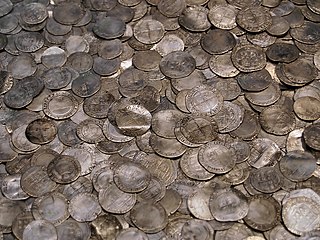
A hoard or "wealth deposit" is an archaeological term for a collection of valuable objects or artifacts, sometimes purposely buried in the ground, in which case it is sometimes also known as a cache. This would usually be with the intention of later recovery by the hoarder; hoarders sometimes died or were unable to return for other reasons before retrieving the hoard, and these surviving hoards might then be uncovered much later by metal detector hobbyists, members of the public, and archaeologists.

A treasure trove is an amount of money or coin, gold, silver, plate, or bullion found hidden underground or in places such as cellars or attics, where the treasure seems old enough for it to be presumed that the true owner is dead and the heirs undiscoverable. An archaeological find of treasure trove is known as a hoard. The legal definition of what constitutes treasure trove and its treatment under law vary considerably from country to country, and from era to era.

The Cuerdale Hoard is a hoard of more than 8,600 items, including silver coins, English and Carolingian jewellery, hacksilver and ingots. It was discovered on 15 May 1840 on the southern bank of a bend of the River Ribble, in an area called Cuerdale near Preston, Lancashire, England. The Cuerdale Hoard is one of the largest Viking silver hoards ever found, four times larger than its nearest rival in Britain or Ireland, according to Richard Hall. In weight and number of pieces, it is second only to the Spillings Hoard found on Gotland, Sweden.

The Hoxne Hoard is the largest hoard of late Roman silver and gold discovered in Britain, and the largest collection of gold and silver coins of the fourth and fifth centuries found anywhere within the former Roman Empire. It was found by Eric Lawes, a metal detectorist in the village of Hoxne in Suffolk, England in 1992. The hoard consists of 14,865 Roman gold, silver, and bronze coins and approximately 200 items of silver tableware and gold jewellery. The objects are now in the British Museum in London, where the most important pieces and a selection of the rest are on permanent display. In 1993, the Treasure Valuation Committee valued the hoard at £1.75 million.
Confederate gold refers to hidden caches of gold lost after the American Civil War. Millions of dollars' worth of gold was lost or unaccounted for after the war, and its possible location has been the source of speculation of many historians and treasure hunters. Allegedly, some of the Confederate treasury was hidden in order to wait for the rising again of the South and at other times simply so that the Union would not gain possession of it.
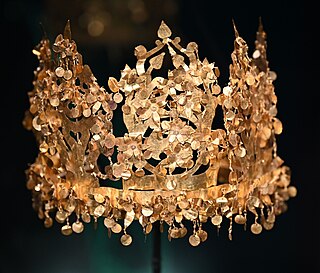
Tillya tepe, Tillia tepe or Tillā tapa is an archaeological site in the northern Afghanistan province of Jowzjan near Sheberghan, excavated in 1978 by a Soviet-Afghan team led by the Soviet archaeologist Viktor Sarianidi. The hoard found there is often known as the Bactrian gold.
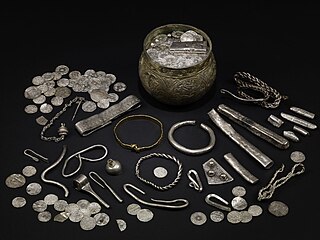
The Vale of York Hoard, also known as the Harrogate Hoard and the Vale of York Viking Hoard, is a 10th-century Viking hoard of 617 silver coins and 65 other items. It was found undisturbed in 2007 near the town of Harrogate in North Yorkshire, England. The hoard was the largest Viking one discovered in Britain since 1840, when the Cuerdale hoard was found in Lancashire, though the Anglo-Saxon Staffordshire Hoard, found in 2009, is larger.
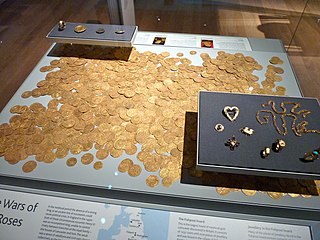
In 1966 the Fishpool Hoard of 1,237 15th century gold coins, four rings and four other pieces of jewellery, and two lengths of gold chain was discovered by workmen on a building site near present-day Cambourne Gardens, in Ravenshead, Nottinghamshire, England, an area that was then known as "Fishpool". It is the largest hoard of medieval coins ever found in Britain. To judge from the dates of the coins, the hoard was probably buried in haste at some time between winter 1463 and summer 1464, perhaps by someone fleeing south after the Battle of Hexham in May 1464, in the first stages of England's civil war between aristocratic factions, the War of the Roses. The Fishpool Hoard, on display in Room 40 in the British Museum, London, was listed in 2003 among Our Top Ten Treasures, a special episode of BBC Television series Meet the Ancestors that profiled the ten most important treasures ever unearthed in Britain as voted by a panel of experts from the British Museum. The British Museum assesses the face value of the hoard when deposited, about £400, would be equivalent to around £300,000 today.
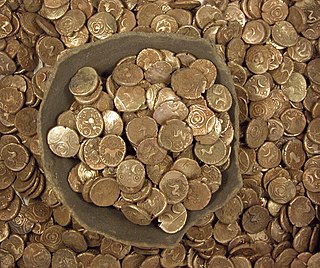
The Wickham Market Hoard is a hoard of 840 Iron Age gold staters found in a field at Dallinghoo near Wickham Market, Suffolk, England in March 2008 by car mechanic, Michael Dark using a metal detector. After excavation of the site, a total of 825 coins were found, and by the time the hoard was declared treasure trove, 840 coins had been discovered. The coins date from 40 BC to 15 AD.

The Saddle Ridge Hoard is the name given to a hoard of 1,427 gold coins unearthed in the western half of the Shasta Cascade region, of Northern California in 2013. The face value of the coins totaled $27,980, but was assessed to be worth $10 million. The hoard contains $27,460 in twenty-dollar coins, $500 in ten-dollar coins, and $20 in five-dollar coins, all dating from 1847 to 1894. The collection is the largest known discovery of buried gold coins that has ever been recovered in the United States.
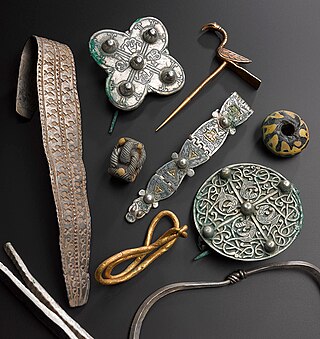
The Galloway Hoard, currently held in the National Museum of Scotland, is a hoard of more than 100 gold, silver, glass, crystal, stone, and earthen objects from the Viking Age discovered in the historical county of Kirkcudbrightshire in Dumfries and Galloway in Scotland in September 2014. Found on Church of Scotland land, the hoard has been described by experts as "one of the most significant Viking hoards ever found in Scotland". With years of extensive study and research, scholars are still not certain who buried the hoard, why they did so and whether they were Vikings or Anglo-Saxons. During the Viking Age, Galloway found itself squeezed between two Viking kingdoms and essentially cut off from other Anglo-Saxons in Britain - "Galloway is where these different cultures were meeting. It’s not just Scandinavians, but people from Britain and Ireland as well."
The Lenborough Hoard is a hoard of more than 5,000 late Anglo-Saxon silver coins, dating to the eleventh century, that was found at Lenborough in Buckinghamshire, England in 2014. It is believed to be one of the largest hoards of Anglo-Saxon coins ever found in Britain. It is now on display at Discover Bucks Museum.

The Castine Hoard is the name given to a treasure trove of around 500–2,000 North American colonial coins that were found in Castine, Maine. The coins were from various countries, and were buried sometime in the late 1600s. In the early 1840s the coins were discovered on a farm owned by the Grindle family.

The Trier Gold Hoard is a hoard of 2516 gold coins with a weight of 18.5 kg found in Trier, Germany, in September 1993 during construction works. It is described as the largest preserved Roman gold hoard worldwide. The hoard is on exhibition at the Rheinisches Landesmuseum Trier.

In 1934, a hoard of gold coins was discovered by two teenage boys in Baltimore, Maryland. The two boys discovered copper pots containing 3,558 gold coins while digging in the dirt of a cellar. One year later the two boys discovered a second hoard in the same location. The total value of both hoards was US$30,000.
This page lists major events of 2021 in archaeology.
The Great Kentucky Hoard is a hoard of more than 700 gold coins unearthed in an undisclosed part of Kentucky, United States, in the 2020s by a man on his own land. The finder of the hoard has remained anonymous.












